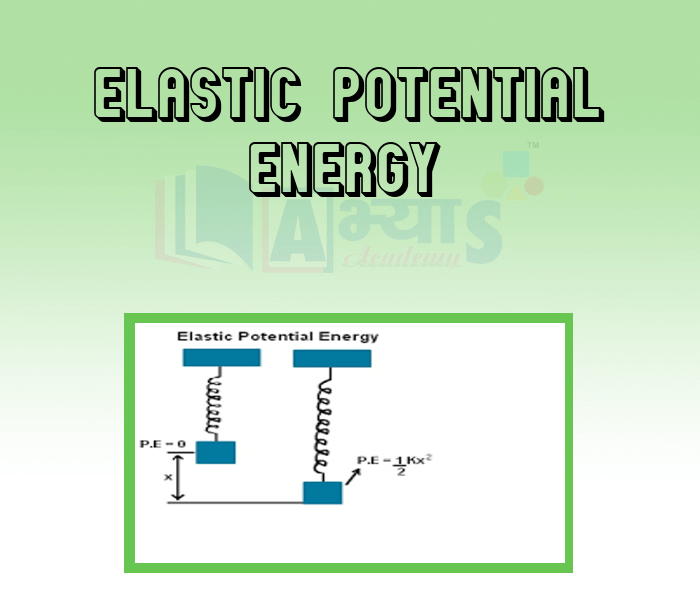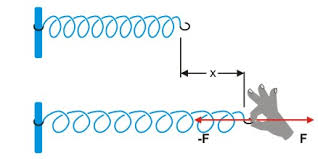Elastic Potential Energy










Elastic Potential Energy
Elastic Potential Energy
This is a kind of potential energy which is due to a change in the shape of body. The change in shape of a body can be brought about by stretching, compressing, bending and twisting the body. Some work has to be done to change the shape of a body. This work gets stored in the deformed body in the form of elastic potential energy.
For example, the energy stored in a stretched rubber band or a spring is elastic potential energy and is equal to the work done in stretching the rubber band or spring. When this deformed body is released, it attains its original shape and the potential energy is converted into some other form, usually in kinetic energy. Elastic potential energy is never negative whether due to extension or to compression.

A stretched rubber band can do some work while coming back to its normal position, so we can say that the stretched rubber band has gained some energy because of stretching. This is elastic potential energy. A rubber band at its natural length while lying on the table does not have any ability to do some work, that is it does not have any energy.
A catapult (gulet) works on the principle elastic potential energy. A catapult has a thick rubber band whose two ends are tied to the two arms of the catapult. The band is pulled while holding a small object in its fold.

When the band is stretched it gains some potential energy. As the band is released it comes back to its normal position. While doing so it gives a push to the small object, which in turn gains some kinetic energy and accelerates at a great speed while leaving the catapult.
Which of the following statements are not true for gaining elastic potential energy. 1. Due to a change in the shape of body. 2. By stretching an object 3. By compressing an object 4. By bending an object 5. By pushing an object 6. By twisting an object | |||
| Right Option : D | |||
| View Explanation | |||
Which of the following statements are true 1. The energy stored in a stretched rubber band or a spring is elastic potential energy.and is equal to the work done in stretching the rubber band or spring. 2. When this deformed body is released, it attains its original shape and the potential energy is converted into some other form, usually in kinetic energy. 3. Elastic potential energy is never negative whether due to extension or to compression. instrument works on the principle of elastic potential energy. | |||
| Right Option : D | |||
| View Explanation | |||
Which of the following instrument works on the principle of elastic potential energy. | |||
| Right Option : D | |||
| View Explanation | |||
Students / Parents Reviews [20]
Abhyas academy is great place to learn. I have learnt a lot here they have finished my fear of not answering.It has created a habit of self studying in me.The teachers here are very supportive and helpful. Earlier my maths and science was good but now it has been much better than before.

Barkha Arora
10thThe experience was nice. I studied here for three years and saw a tremendous change in myself. I started liking subjects like English and SST which earlier I ran from. Extra knowledge gave me confidence to overcome competitive exams. One of the best institutes for secondary education.

Aman Kumar Shrivastava
10thAbhyas is a complete education Institute. Here extreme care is taken by teacher with the help of regular exam. Extra classes also conducted by the institute, if the student is weak.

Om Umang
10thOne of the best institutes to develope a child interest in studies.Provides SST and English knowledge also unlike other institutes. Teachers are co operative and friendly online tests andPPT develope practical knowledge also.

Aman Kumar Shrivastava
10thA marvelous experience with Abhyas. I am glad to share that my ward has achieved more than enough at the Ambala ABHYAS centre. Years have passed on and more and more he has gained. May the centre flourish and develop day by day by the grace of God.

Archit Segal
7thAbout Abhyas metholodology the teachers are very nice and hardworking toward students.The Centre Head Mrs Anu Sethi is also a brilliant teacher.Abhyas has taught me how to overcome problems and has always taken my doubts and suppoeted me.

Shreya Shrivastava
8thAbhyas is an institute of high repute. Yogansh has taken admission last year. It creates abilities in child to prepare for competitive exams. Students are motivated by living prizes on basis of performance in Abhyas exams. He is satisfied with institute.

Yogansh Nyasi
7thBeing a parent, I saw my daughter improvement in her studies by seeing a good result in all day to day compititive exam TMO, NSO, IEO etc and as well as studies. I have got a fruitful result from my daughter.

Prisha Gupta
8thIt was a good experience with Abhyas Academy. I even faced problems in starting but slowly and steadily overcomed. Especially reasoning classes helped me a lot.

Cheshta
10thMy experience was very good with Abhyas academy. I am studying here from 6th class and I am satisfied by its results in my life. I improved a lot here ahead of school syllabus.

Ayan Ghosh
8thMy experience with Abhyas is very good. I have learnt many things here like vedic maths and reasoning also. Teachers here first take our doubts and then there are assignments to verify our weak points.

Shivam Rana
7thMy experience with Abhyas Academy has been very good. When I was not in Abhyas whenever teacher ask questions I could not speak it confidently but when I came in Abhyas, my speaking skills developed and now I am the first one to give the answer of teachers question.

Upmanyu Sharma
7thIt was good as the experience because as we had come here we had been improved in a such envirnment created here.Extra is taught which is beneficial for future.

Eshan Arora
8thAbhyas Methodology is very good. It is based on according to student and each child manages accordingly to its properly. Methodology has improved the abilities of students to shine them in future.

Manish Kumar
10thThird consective year,my ward is in Abhyas with nice experience of admin and transport support.Educational standard of the institute recumbent at satisfactory level. One thing would live to bring in notice that last year study books was distributed after half of the session was over,though study ...

Ayan Ghosh
8thAbhyas is good institution and a innovative institute also. It is a good platform of beginners.Due to Abhyas,he has got knoweledge about reasoning and confidence.My son has improved his vocabulary because of Abhyas.Teacher have very friendly atmosphere also.

Manish Kumar
10thWe started with lot of hope that Abhyas will help in better understnding of complex topics of highers classes. we are not disappointed with the progress our child has made after attending Abhyas. Though need to mention that we expected a lot more. On a scale of 1-10, we would give may be 7.

Manya
8thUsually we see institutes offering objective based learning which usually causes a lag behind in subjective examinations which is the pattern followed by schools. I think it is really a work of planning to make us students grab the advantages of modes of examination, Objective Subjective and Onli...

Anika Saxena
8thAbhyas institute is one of the best coaching institute in the vicinity of Ambala cantt.The institute provides good and quality education to the students.The teachers are well experienced and are very helpful in solving the problems. The major advantages of the institute is extra classes for weak...

Shreya Shrivastava
8thMy experience with Abhyas academy is very good. I did not think that my every subject coming here will be so strong. The main thing is that the online tests had made me learn here more things.
